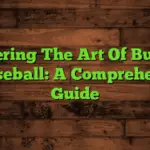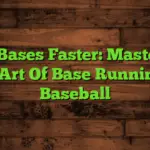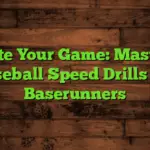Choosing the right baseball cleats can significantly impact your performance on the field. This comprehensive guide will walk you through everything you need to know to select the perfect pair, covering factors like fit, type, features, and maintenance. We’ll explore different cleat types, materials, and brands to help you make an informed decision, whether you’re a seasoned pro or just starting out. You’ll learn how to assess your playing style, understand your foot shape, and find cleats that offer optimal comfort, support, and traction. Get ready to elevate your game!
Baseball cleats are specialized footwear designed for the unique demands of the baseball field. Unlike regular athletic shoes, baseball cleats feature strategically placed spikes or studs that provide superior traction, grip, and stability on the playing surface, enabling quick movements, explosive starts, and secure
footing during pivotal moments of the game.
Why are the Right Cleats Crucial?
Proper cleats are essential for both performance and injury prevention. Poor traction can lead to slips, falls, and potentially serious injuries. The right cleats provide the necessary support and stability to prevent ankle sprains, knee problems, and other common baseball-related injuries. Furthermore, comfortable and supportive cleats allow players to focus on the game without distractions from discomfort.
Types of Baseball Cleats
Metal Cleats: Traditional and Durable
Metal cleats offer exceptional traction and durability, making them a favorite among many serious players. The longer spikes provide superior grip, especially on softer surfaces. However, they are often heavier than other options and may be restricted in some leagues due to safety concerns.
Plastic Cleats: Lightweight and Versatile
Plastic cleats provide a good balance of traction, comfort, and weight. They are generally lighter than metal cleats and offer better flexibility, making them suitable for a variety of playing surfaces. These cleats are a popular choice for both amateur and professional players.
Rubber Cleats: Comfort and Durability
Rubber cleats offer excellent cushioning and comfort. Their versatility makes them great for players who need a balance between protection and comfort. They are lightweight, but not as durable as metal cleats. They work well on different surfaces.
Cleat Features: What to Look For
Sole Plate: The Foundation of Traction
The sole plate is the base of the cleat, determining its overall performance. Different sole plates offer varying degrees of flexibility, support, and traction. Consider the material (e.g., TPU, nylon) and the spike configuration (e.g., number, length, placement).
Spike Type and Configuration: Grip and Stability
The type and placement of spikes significantly impact traction and stability. Metal spikes generally offer superior grip but may be restricted in certain leagues. Plastic or rubber studs offer a less aggressive grip but are more versatile and safer.
Upper Material: Comfort and Support
The upper material of the cleat affects comfort, breathability, and durability. Leather provides superior support and durability but can be heavier and less breathable. Synthetic materials are lighter, more breathable, and often more affordable.
Finding the Right Fit: A Crucial Step
Understanding Your Foot Shape
Before you purchase cleats, it’s important to understand your foot shape. Are your feet wide, narrow, high-arched, or flat-footed? A proper fit minimizes discomfort and prevents injuries. Consider visiting a sporting goods store for professional fitting guidance.
Testing the Fit: The Ultimate Test
Don’t just rely on shoe size. Always try on cleats before purchasing them. Walk around in them, perform some light jumps and twists to assess the comfort and support. Make sure there’s enough room in the toe box, and that the cleats feel snug but not restrictive.
Considering Socks and Insoles
The type of socks you wear can also affect the fit of your cleats. Consider thicker socks if you plan to wear them during gameplay. Custom insoles can provide additional support and comfort, especially for those with specific foot conditions.
Choosing the Right Cleats for Your Playing Style
Position-Specific Needs
Different positions in baseball demand different requirements from cleats. Infielders often prioritize agility and quick lateral movements, favoring lighter, more flexible cleats. Pitchers often require cleats with excellent stability and traction, especially during their pitching motion. Outfielders need durability and traction for long strides and running.
Level of Play: Amateur vs. Professional
The intensity of play influences the type of cleat you need. Amateur players might find more affordable options sufficient, while professionals might prefer higher-end models with advanced features and increased durability.
Popular Baseball Cleat Brands
Nike: Innovation and Performance
Nike produces a wide range of baseball cleats, known for their innovative designs and high-performance features. Their cleats are popular among both amateur and professional players, covering a wide price range. They often use high-tech materials and cutting-edge designs.
Under Armour: Comfort and Support
Under Armour cleats are celebrated for their comfortable and supportive designs. They often feature advanced cushioning and support technologies, prioritizing player comfort and minimizing the risk of injuries. They are available across various price points.
Adidas: Style and Performance
Adidas cleats offer a blend of style and performance. They offer a good balance of comfort, support, and traction, with stylish designs appealing to many players. Their cleats are often known for their lightweight designs and excellent grip.
Cleat Maintenance: Prolonging Their Life
Cleaning Your Cleats: Simple Tips
Regular cleaning extends the life of your cleats. After each game or practice, use a brush and water to remove mud and debris. You can also use a mild soap solution for stubborn stains.
Drying Your Cleats: Preventing Damage
Never put your cleats in a dryer. Allow them to air dry naturally, away from direct sunlight or heat. Stuffing them with newspaper can help maintain their shape and accelerate drying.
Storage: Protecting Your Investment
Proper storage prevents damage and prolongs the lifespan of your cleats. Store them in a cool, dry place, away from direct sunlight and moisture. Consider using a shoe bag or container for protection.
Budgeting for Your Baseball Cleats: A Realistic Approach
Price Range Considerations
Baseball cleats range in price from affordable options suitable for casual players to high-end models for professionals. Consider your budget and level of play when making your choice. It is essential to find a balance between price and quality.
Value for Money: Prioritizing Key Features
Focus on features that matter most to you, such as comfort, support, and traction. Don’t overspend on features you won’t utilize. Prioritizing key features will help you get the best value for your money.
Frequently Asked Questions
What is the difference between metal and plastic cleats?
Metal cleats offer superior grip but can be heavier and restricted in some leagues. Plastic cleats provide a lighter and more versatile option with decent traction. The choice depends on league regulations and personal preference.
How often should I replace my baseball cleats?
The lifespan of baseball cleats varies depending on usage and the type of cleat. Generally, you should replace them when the spikes are worn down, the sole shows significant wear, or the overall structure feels compromised. Excessive wear increases the risk of injury.
Can I use baseball cleats for other sports?
While baseball cleats offer exceptional traction for baseball, they aren’t suitable for other sports like soccer or running. The spike configuration is designed for baseball’s specific movements and playing surfaces. Using them in other sports might lead to injury.
How do I break in new baseball cleats?
To break in new cleats, wear them around the house for short periods, gradually increasing the duration. You can also use a shoe stretcher to gently widen them in specific areas. Remember, don’t wear new cleats during a game without breaking them in beforehand.
What are some common baseball cleat injuries?
Common injuries include ankle sprains, knee injuries, and blisters. Improper fit and worn-out cleats significantly increase the risk of these injuries. Always prioritize comfort and support to minimize these risks.
Final Thoughts
Choosing the best baseball cleats involves careful consideration of various factors including your playing style, foot shape, budget, and the features offered by different brands. Understanding the different types of cleats, their features, and the importance of proper fit is crucial for maximizing performance and preventing injuries. Remember to prioritize comfort, support, and appropriate traction for your playing surface. By following the guidance outlined in this comprehensive guide, you can confidently select the perfect pair of baseball cleats to elevate your game and enhance your overall experience on the field. Don’t hesitate to visit your local sporting goods store for expert advice and try on several pairs before making your final decision. Investing in high-quality cleats is an investment in your performance and well-being.





